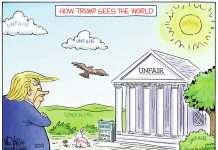Fort Wayne Journal Gazette
Amid the pantheon of ecological problems, endangered wetlands face a PR challenge: They are, in the public mind, synonymous with swamps. And swamps, in turn, are synonymous with snakes and mosquitoes.
But those images are misleading. “A wetland,” Indra Frank of the Hoosier Environmental Council explained, “is defined by being saturated with water at least a portion of the year and saturated enough to change the nature of the plants and soil there.” The term may also comprise bogs, grasslands, fens, prairies, marshes and forests, as well as swamps – which, you may have noticed, hold no monopoly on the state’s mosquitoes.
People willing to brush aside wetlands’ value as home for a diversity of wildlife need to remember that wetlands are also a vital part of the state’s water system. “We’ve lost approximately 90% of the state’s original wetlands,” Frank said. “But now we’re receiving more precipitation than we used to, and more of it is arriving in heavy storms.
“Those wetlands are like giant sponges that can help soak up excess stormwater and reduce floodwater,” Frank continued. “We actually need them more than ever.”
A state task force representing a spectrum of interests on the issue made similar observations in a report issued last November, emphasizing the impact wetland reductions can have on water quality, as well as control of flooding “and the loss of agricultural income, damage to infrastructure, and significant economic hardship.”
Recently, the U.S. Supreme Court issued a ruling that removes wetlands not directly connected to a stream or lake from federal protection. The change will be felt throughout Indiana.
Before the court’s ruling, Frank said, 80% of Hoosier wetlands had federal protection; state regulations covered some of the remaining 20%. But going forward, Frank estimates that protection could shrink to 20% or less. Thus, the numbers may be in effect reversed: 80% of the state’s wetlands could be vulnerable to unregulated development unless Hoosiers step up to defend them.
Going forward, Indiana’s legislature no longer has the luxury of chipping away at wetland law to curry favor with heedless developers.
But Hoosiers don’t have to wait for a change of heart by Republican supermajorities at the Statehouse. Advocates must find a way to show those beyond the environmental/outdoor-group axis that voluntarily conserving wetlands is in everyone’s interest. As the state task force put it: “Indiana is at a point where the cumulative loss of wetlands is having a measurable negative impact on residents.”
Potential damage to Indiana’s wetlands can only be averted by Hoosiers working together in the best interests of their state. As a rallying cry, “save the wetlands” is not exactly the inland equivalent of “save the whales.” But that needs to change. Now more than ever.




